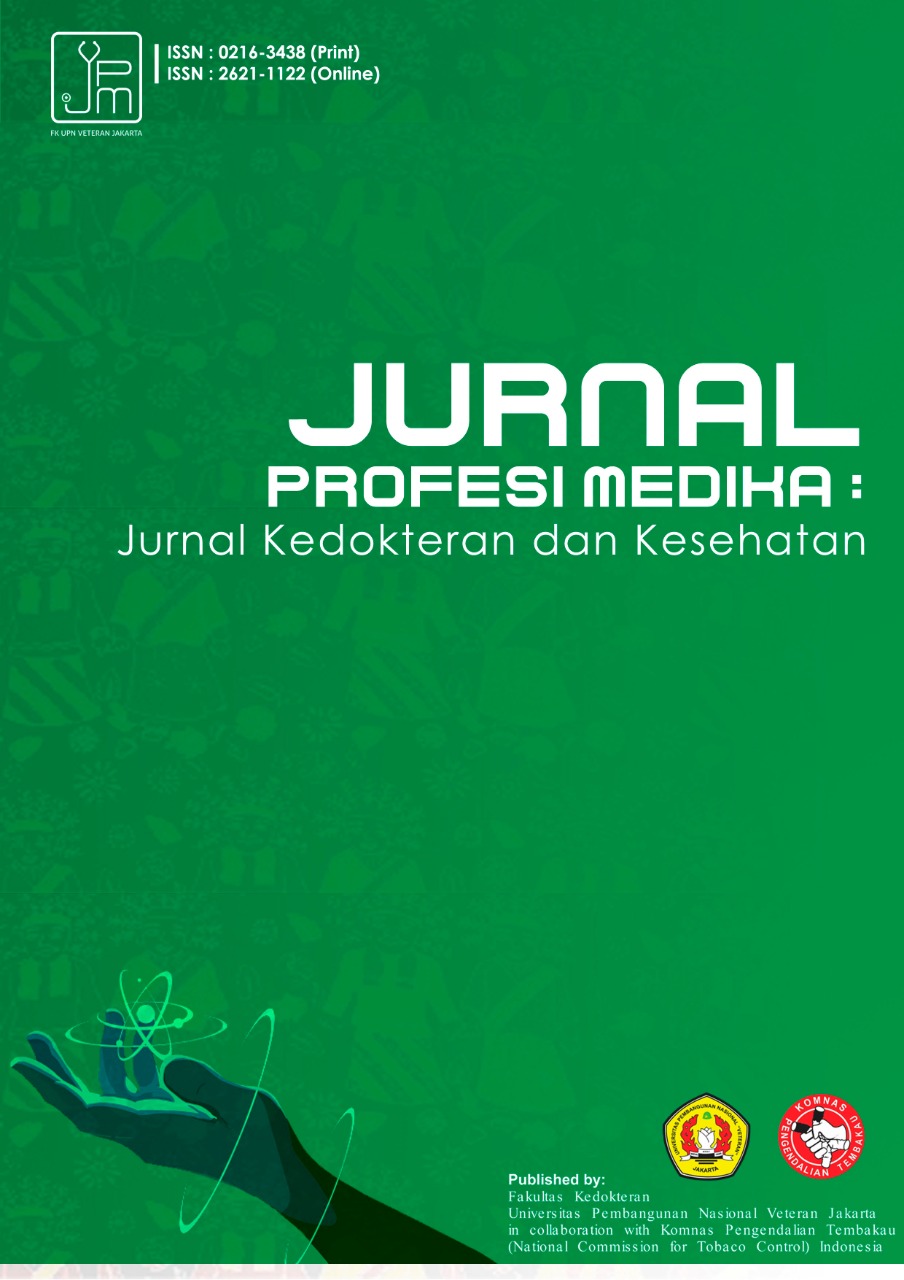The Correlation Between Nutritional Status, Age, and Gender on the Incidence of Soil-Transmitted Helminth Infections
DOI:
https://doi.org/10.33533/jpm.v17i2.6896Keywords:
Age, Gender, Infection, Nutritional status, Soil-transmitted helminthAbstract
Soil-transmitted helminth (STH) infections most commonly infect preschool and school-age children. The prevalence of STH infection remains high, i.e., 73 million children are infected in Indonesia. The most commonly infecting worms are roundworms (Ascaris lumbricoides), whipworms (Trichuris trichiura), and hookworms (Ancylostoma duodenale and Necator americanus). STH infection is transmitted through soil contaminated by STH eggs or larvae. Personal hygiene, availability of clean water, and defecation behavior are factors in the development of STH infection. Prolonged infection can cause malnutrition, anemia, and slow growth. This study aims to examine the association between nutritional status, age, and gender on the incidence of STH infection. This research is a descriptive-analytical study with a cross-sectional approach. Fifteen (42.86%) of 35 preschool and school-age children's stool samples were positive for Ascaris lumbricoides eggs. The nutritional status of the children was grouped into underweight, normal, and overweight. The body mass index (BMI) calculation resulted in 65.71% (23/35) underweight, 31.43% (11/35) normal, and 2.86% (1/35) overweight children. The Spearmen test shows that there is no significant correlation between nutritional status (p=0.517), age (p=0.614), and gender (p=0.637) on STH infection.
References
[1]. Organization, W. H. (2023). Soil-transmitted helmin infections. Retrieved from https://www.who.int/news-room/fact-sheets/detail/soil-transmitted-helminth-infections
[2]. Organization, W. H. (2021). Soil-transmitted helminthiases. Number of children (Pre-SAC dan SAC) requiring preventive chemotherapy for soil-transmitted helminthiases. Retrieved from https://apps.who.int/neglected_diseases/ntddata/sth/sth.html
[3]. Novianty S, Pasaribu HS, Pasaribu AP. (2018). Faktor Risiko Kejadian Kecacingan Pada Usia Pra Sekolah. J Indon Med Assoc, Volum: 68, Nomor 2.
[4]. Tapiheru MJR, Nurfadly. (2021). Prevalensi Infeksi Soil Transmitted Helminth Pada Murid Sekolah Dasar Negeri 105296 Kecamatan Percut Sei Tuan, Kabupaten Deli Serdang, Sumatera Utara. JIMKI Volume 8 No.3. https://doi.org/10.53366/jimki.v8i3.249
[5]. Nasution RKA, Nasution BB, Lubis M, Lubis IND. (2019). Prevalence and Knowledge of Soil-Transmitted Helminth Infections in Mandailing Natal, North Sumatera, Indonesia. Open Access Maced J Med Sci. Volume 7(20), 3443 - 2446. https://doi.org/10.3889/oamjms.2019.441
[6]. Alemu Y, Degefa T, Bajiro M, Teshome G. (2022). Prevalence and intensity of soil-transmitted helminths infection among individuals in model and non-model households, South West Ethiopia: A comparative cross-sectional community based study . PLOS ONE 17(10):e0276137 https://doi.org/10.1371/journal.pone.0276137
[7]. Ballweber LR, Beugnet F, Marchiondoc AA. (2014). American Association of Veterinary Parasitologists’ review of Veterinary Parasitologists’ review of veterinary fecal flotation methods and factors influencing their accuracy and use—Is there really one best technique? 73 - 80.
[8]. Rahayu AT, Pratama A, Setiawan MW, Ma’rifatussolihat, Nikmatullah NA. Optimasi Metode Flotasi Sentrifus Menggunakan Larutan ZnSO4, MgSO4, dan NaCl Berdasarkan Konsentrasi Larutan dan Lama Pengapungan. Jurnal Media Analis Kesehatan Vol. 14 No.1, Juni 2023. https://doi.org/10.32382/mak.v14i1.3283
[9]. Djuardi Y, Lazarus G, Stefanie D, Fahmida U, Ariawan I, Supali T. (2021). Soil-transmitted helminth infection, anemia, and malnutrition among preschool-age children in Nangapanda subdistrict, Indonesia. . PLoS Negl Trop Dis 15(6):e0009506. https://doi.org/10.1371/journal.pntd.0009506
[10]. Kurscheid J, Laksono B, Park MJ, Clements ACA, Sadler R, McCarthy JS, et al. (2020). Epidemiology of soil-transmitted helminth infections in Semarang, Central Java, Indonesia. PLoS Negl Trop Dis 14(12): e0008907. https://doi.org/10.1371/journal.pntd.0008907
[11]. Sihura PNF, Augustina I, Jabal AR. Literature Review: Hubungan Higienitas Perorangan Dengan Kejadian Infeksi Cacingan (Soil Transmitted Helminths) Pada Anak Usia Sekolah Dasar. Jurnal Kedokteran Universitas Palangka Raya, Vol 10 (1): 1 – 7, 2022. DOI: 10.37304/jkupr.v10i1.3496
[12]. Irwan MIK, Fattah N, Arfah AI, Esa AH, Laddo N, Ningsih ES. Faktor Risiko Infeksi Kejadian Kecacingan pada Anak Usia Sekolah di Wilayah Kerja Puskesmas Panambungan Makassar. Fakumi Medical Journal: Jurnal Mahasiswa Kedokteran Vol. 3 No.4 (April, 2023).
[13]. Juhairiyah, Hairani B, Indriyati L. Prevalensi Infeksi Cacing Pada Murid Sekolah Dasar Negeri 1 Harapan Maju Kecamatan Karang Bintang Kabupaten Tanah Bumbu, SPIRAKEL, 9(1), 2017, 27 – 33
[14]. Halleyantoro R, Riansari A, & Dewi DP. Insidensi dan Analisis Faktor Risiko Cacing Tambang Pada Siswa Sekolah Dasar di Grobogan, Jawa Tengah. Jurnal Kedokteran Raflesia, 5(1),2019, 18 – 27
[15]. Novitasari NA, Fatah MZ. Systematic Review Faktor Risiko Infeksi Parasit Usus. Media Gizi Kesmas, Vol. 10, No.1, Juni 2021: Halaman: 165 – 179
[16]. Annisa S, Dalilah, Anwar C. Hubungan Infeksi Cacing Soil Transmitted Helminths ( STH ) dengan Status Gizi pada Siswa Sekolah Dasar Negeri 200 Kelurahan Kemasrindo Kecamatan Kertapati Kota Palembang Helminths (STH) 1 Penyakit ini termasuk dalam kelompok Neglected Tropical Diseases. Majalah Kedokteran Sriwijaya. 2018.
[17]. Ramadhani R, Sawitri H, Maulina N. Hubungan Infeksi Soil Transmitted Helminths (STH) dengan Status Gizi pada Siswa/Siswi Sekolah Dasar Negeri (SDN) 8 Pusong Lama Kecamatan Banda Sakti Kota Lhokseumawe Tahun 2022. GALENICAL: Jurnal Kedokteran dan Kesehatan Mahasiswa Malikussaleh Vol.1 No.4 November 2022.
[18]. Rehabil Med. 2013 Apr ; 56(3): 193-211 doi : 10.1016/j.rehab2013.01.008
Downloads
Published
How to Cite
Issue
Section
Categories
License
Copyright (c) 2023 Jurnal Profesi Medika : Jurnal Kedokteran dan Kesehatan

This work is licensed under a Creative Commons Attribution-NonCommercial 4.0 International License.
Copyright Notice
All articles submitted by the author and published in the Jurnal Profesi Medika : Jurnal Kedokteran dan Kesehatan, are fully copyrighted by the publication of Jurnal Profesi Medika : Jurnal Kedokteran dan Kesehatan under the Creative Commons Attribution-NonCommercial 4.0 International License by technically filling out the copyright transfer agreement and sending it to the publisher
Note :
The author can include in separate contractual arrangements for the non-exclusive distribution of rich versions of journal publications (for example: posting them to an institutional repository or publishing them in a book), with the acknowledgment of their initial publication in this journal.
Authors are permitted and encouraged to post their work online (for example: in an institutional repository or on their website) before and during the submission process because it can lead to productive exchanges, as well as earlier and more powerful citations of published works. (See Open Access Effects).






